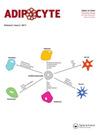核受体NR1D1和ULK1的组合促进脂肪细胞的线粒体自噬以改善肥胖
IF 3.5
4区 生物学
Q2 ENDOCRINOLOGY & METABOLISM
引用次数: 2
摘要
摘要肥胖是一种全球性的严重疾病。线粒体自噬可能与肥胖个体的代谢异常有关,但其机制尚不清楚。我们的目的是研究核受体NR1D1和ULK1是否通过影响线粒体自噬来影响肥胖。通过诱导3T3-L1细胞分化建立体外模型。MTT法检测细胞活力。ELISA法检测甘油三酯(TG)。进行油红O染色以检测脂滴。流式细胞术检测线粒体活性氧。ChIP和双荧光素酶报告基因测定证实NR1D1与ULK1结合。通过IF检测LC3水平。分化培养基处理后,模型组细胞活力下降,TG含量和脂滴增加,NR1D1表达降低。NR1D1过表达增加了细胞活力,降低了TG含量和脂滴。随后,NR1D1抑制TOM20和mtROS,而Parkin和PINK1加速。NR1D1过表达促进了LC3的表达,而ULK1敲低则逆转了NR1D1过度表达的作用。Liensinine还逆转了NR1D1过表达的作用,即细胞活力降低,mtROS、TG含量和脂滴增加。核受体NR1D1和ULK1的结合促进脂肪细胞的线粒体自噬以减轻肥胖,为肥胖治疗提供了新的靶点和策略。缩写:线粒体自噬(线粒体自噬)、甘油三酯(TG)、非配位-51样自噬激活激酶1(ULK1)、核受体亚家族1组D成员1(NR1D1)、美国典型培养物保藏中心(ATCC)、胎牛血清(FBS)、3-异丁基-1-甲基黄嘌呤(IBMX)、地塞米松(DEX)、短发夹RNA ULK1(sh-ULK1)、野生型(WT)、突变体(MUT),酶联免疫吸附试验(ELISA)、线粒体活性氧(mtROS)、染色质免疫沉淀(ChIP)、实时定量PCR(qRT-PCR)、免疫荧光(IF)、标准差(SD)。本文章由计算机程序翻译,如有差异,请以英文原文为准。
The combination of nuclear receptor NR1D1 and ULK1 promotes mitophagy in adipocytes to ameliorate obesity
ABSTRACT Obesity is a severe disease worldwide. Mitochondrial autophagy (mitophagy) may be related to metabolic abnormalities in obese individuals, but the mechanism is still unclear. We aimed to investigate whether nuclear receptors NR1D1 and ULK1 influence obesity by affecting mitophagy. In vitro model was established by inducing 3T3-L1 cells differentiation. MTT was detected cell viability. ELISA was tested triglyceride (TG). Oil red O staining was performed to detect lipid droplets. Flow cytometry was measured mtROS. ChIP and Dual-luciferase reporter assay were verified NR1D1 bind to ULK1. LC3 level was detected by IF. After differentiation medium treatment, cell viability was decreased, TG content and lipid droplets were increased Moreover, NR1D1 expression was reduced in Model group. NR1D1 overexpression was increased cell viability, reduced TG content and lipid droplets. Subsequently, NR1D1 inhibited TOM20 and mtROS, whereas, Parkin and PINK1 were accelerated. NR1D1 overexpression facilitated LC3 expression, whereas ULK1 knockdown was reversed the effect of NR1D1 overexpression. Liensinine also reversed the effect of NR1D1 overexpression, that is, cell viability was reduced, mtROS, TG content and lipid droplets were increased. The combination of nuclear receptor NR1D1 and ULK1 promoted mitophagy in adipocytes to alleviate obesity, which provided new target and strategy for obesity treatment. Abbreviations: Mitochondrial autophagy (mitophagy), triglyceride (TG), Uncoordinated-51 like autophagy activating kinase 1 (ULK1), Nuclear receptor subfamily 1 group D member 1 (NR1D1), American Type Culture Collection (ATCC), fetal bovine serum (FBS), 3-isobutyl-1-methylxanthine (IBMX), dexamethasone (DEX), short hairpin RNA ULK1 (sh-ULK1), wild-type (WT), mutant (MUT), Enzyme-linked immunosorbent assay (ELISA), mitochondrial reactive oxygen species (mtROS), Chromatin immunoprecipitation (ChIP), Quantitative real-time PCR (qRT-PCR), Immunofluorescence (IF), standard deviation (SD).
求助全文
通过发布文献求助,成功后即可免费获取论文全文。
去求助
来源期刊

Adipocyte
Medicine-Histology
CiteScore
6.50
自引率
3.00%
发文量
46
审稿时长
32 weeks
期刊介绍:
Adipocyte recognizes that the adipose tissue is the largest endocrine organ in the body, and explores the link between dysfunctional adipose tissue and the growing number of chronic diseases including diabetes, hypertension, cardiovascular disease and cancer. Historically, the primary function of the adipose tissue was limited to energy storage and thermoregulation. However, a plethora of research over the past 3 decades has recognized the dynamic role of the adipose tissue and its contribution to a variety of physiological processes including reproduction, angiogenesis, apoptosis, inflammation, blood pressure, coagulation, fibrinolysis, immunity and general metabolic homeostasis. The field of Adipose Tissue research has grown tremendously, and Adipocyte is the first international peer-reviewed journal of its kind providing a multi-disciplinary forum for research focusing exclusively on all aspects of adipose tissue physiology and pathophysiology. Adipocyte accepts high-profile submissions in basic, translational and clinical research.
 求助内容:
求助内容: 应助结果提醒方式:
应助结果提醒方式:


